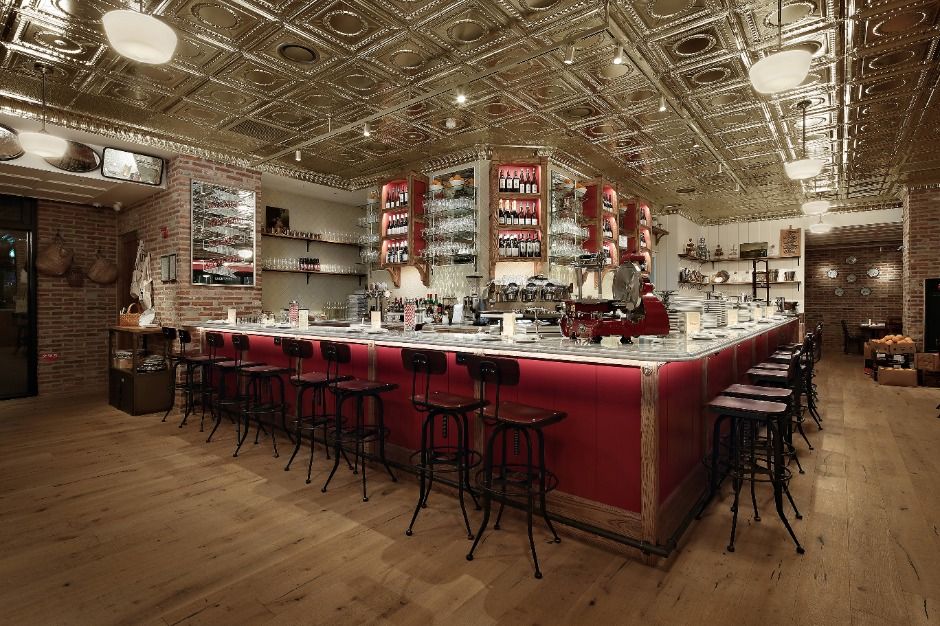Buvette Main Branch (부베트 본점)
6.3Km 2025-12-02
854 Nonhyeon-ro, Gangnam-gu, Seoul
Located in Gangnam, Buvette is a French Gastrotheque where one can enjoy stories and aesthetics of European-style antiques. The place offers heartwarming home-style meals that have been passed down through generations. Early morning coffee and breakfast, lunch with friends, dinner with family, and after-meal cocktails are all possible at Buvette, where delicious food and a lively atmosphere come together to suit a variety of lifestyles. It also has an outdoor terrace that sets the perfect atmosphere for a glass of wine or champagne and is particularly popular among the younger generation. Its signature menu items include of sole meunière, French onion soup, and chorizo oil pasta. The place is easy to find as it is located in a commercial building on the first floor of Andaz Hotel in Apgujeong.
Artbox - Hongik University Branch [Tax Refund Shop] (아트박스 홍대점)
6.3Km 2024-06-27
15, Hongik-ro 6-gil, Mapo-gu, Seoul
-
Bang & Olufsen - Apgujeong Branch [Tax Refund Shop] (뱅앤올룹슨 압구정)
6.3Km 2024-04-18
1F, 865, Eonju-ro, Gangnam-gu, Seoul
-
Gyeongui Line Forest Park (Yeontral Park) (경의선숲길(연트럴파크))
6.3Km 2023-08-11
133, Donggyo-ro 51-gil, Mapo-gu, Seoul
Gyeongui Line Forest Park is a linear city park located in Mapo-gu and is also called Yeontral Park. It includes Daeheung-dong, Yeonnam-dong, Saechanggogae Pass, Changjeon-dong, Sinsu-dong, and Wonhyo-ro, which were opened in this order. Gyeongui Line Forest Park is established atop the Gyeongui railroad line and the Gyeongui Line and Airport Railroad Express are constructed as a double track underground. Gyeongui Line Forest Park was designed to be incomplete on purpose to invite the citizens in completing the park. The area which could have been left empty and neglected has turned into a meaningful green park for the citizens by the citizens.
EW New Balance - Hongik Univ. Branch [Tax Refund Shop] (EW 뉴발란스 홍대)
6.3Km 2024-04-16
20, Hongik-ro, Mapo-gu, Seoul
-
BF Life Sciences Co., Ltd ((주) 비에프생명과학)
6.3Km 2025-10-23
(#1, 5th Floor), 10 Nonhyeon-ro 163-gil, Gangnam-gu, Seoul
BF Life Sciences is a leading company in the international medical cooperation business, specializing in hospital management support, advanced medical services, and research and development. We are at the forefront of next-generation biotechnology, including advanced genome decoding technology and stem cell research, driving innovation in the development of medical devices, pharmaceuticals, cosmetics, and health supplements. Additionally, BF Life Sciences is a global healthcare group providing customized theranostics through collaborations with both domestic and international medical institutions.
Leveraging our expertise in hospital management, we operates overseas branches and hospitals, leading the export of medical services and devices while also conducting various educational programs. BF Life Sciences is registered and licensed with agencies such as the Korea Trade-Investment Promotion Agency (KOTRA), the Ministry of Health and Welfare, and the Korea Food and Drug Administration, ensuring transparent business practices.
Le Labo - Garosu Branch [Tax Refund Shop] (르라보 가로수)
6.3Km 2024-04-18
1F, 28, Apgujeong-ro 10-gil, Gangnam-gu, Seoul
-

![Doctor Petit [Tax Refund Shop] (닥터쁘띠의원)](http://tong.visitkorea.or.kr/cms/resource/86/3314486_image2_1.jpg)
![Artbox - Hongik University Branch [Tax Refund Shop] (아트박스 홍대점)](http://tong.visitkorea.or.kr/cms/resource/78/3314578_image2_1.jpg)
![Bang & Olufsen - Apgujeong Branch [Tax Refund Shop] (뱅앤올룹슨 압구정)](http://tong.visitkorea.or.kr/cms/resource/06/2879606_image2_1.jpg)

![ROROMOON [Tax Refund Shop] (로로문쇼룸)](http://tong.visitkorea.or.kr/cms/resource/71/3312771_image2_1.jpg)
![Monopoly [Tax Refund Shop] (모노폴리)](http://tong.visitkorea.or.kr/cms/resource/00/2879700_image2_1.jpg)
![Le Labo - Garosu Branch [Tax Refund Shop] (르라보 가로수)](http://tong.visitkorea.or.kr/cms/resource/40/2879640_image2_1.jpg)
 English
English
 한국어
한국어 日本語
日本語 中文(简体)
中文(简体) Deutsch
Deutsch Français
Français Español
Español Русский
Русский